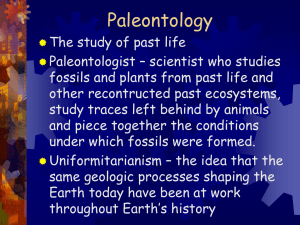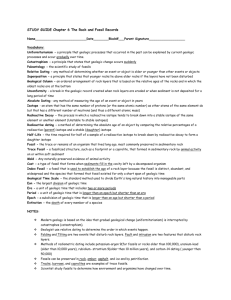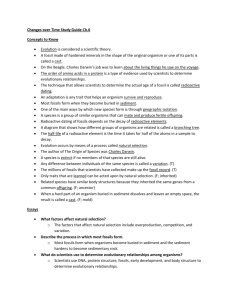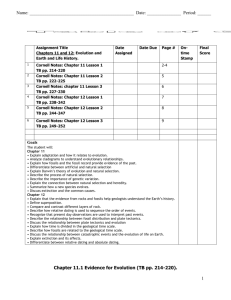Historical Geology Lab
advertisement
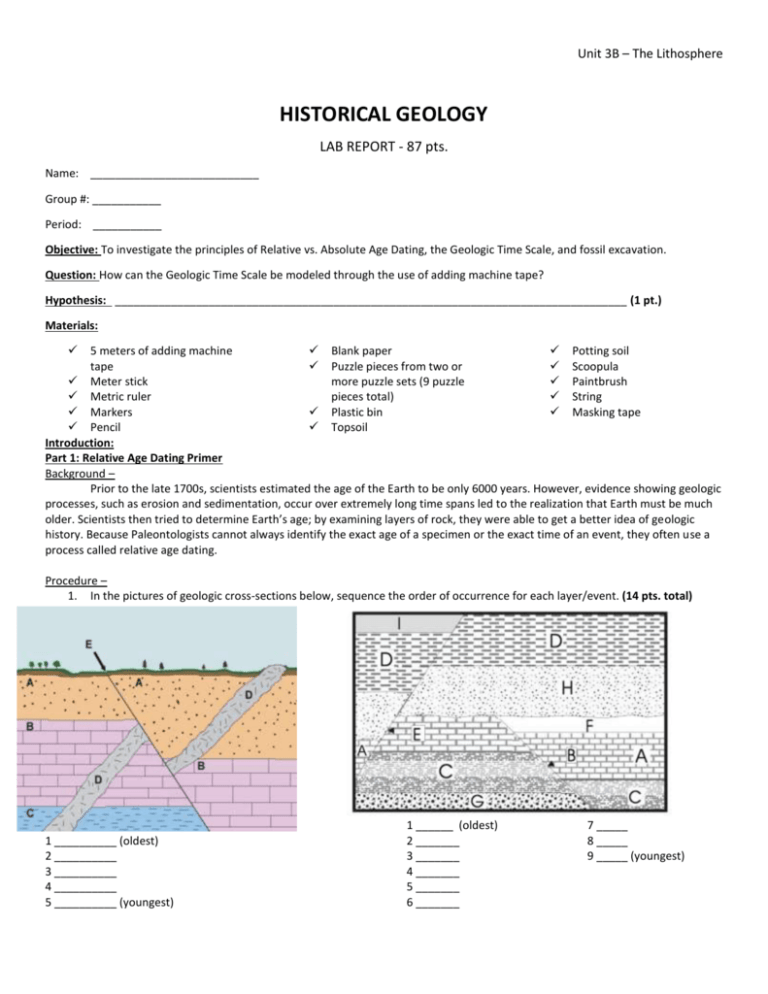
Unit 3B – The Lithosphere HISTORICAL GEOLOGY LAB REPORT - 87 pts. Name: ___________________________ Group #: ___________ Period: ___________ Objective: To investigate the principles of Relative vs. Absolute Age Dating, the Geologic Time Scale, and fossil excavation. Question: How can the Geologic Time Scale be modeled through the use of adding machine tape? Hypothesis: __________________________________________________________________________________ (1 pt.) Materials: 5 meters of adding machine Blank paper Potting soil tape Puzzle pieces from two or Scoopula Meter stick more puzzle sets (9 puzzle Paintbrush Metric ruler pieces total) String Markers Plastic bin Masking tape Pencil Topsoil Introduction: Part 1: Relative Age Dating Primer Background – Prior to the late 1700s, scientists estimated the age of the Earth to be only 6000 years. However, evidence showing geologic processes, such as erosion and sedimentation, occur over extremely long time spans led to the realization that Earth must be much older. Scientists then tried to determine Earth’s age; by examining layers of rock, they were able to get a better idea of geologic history. Because Paleontologists cannot always identify the exact age of a specimen or the exact time of an event, they often use a process called relative age dating. Procedure – 1. In the pictures of geologic cross-sections below, sequence the order of occurrence for each layer/event. (14 pts. total) 1 __________ (oldest) 2 __________ 3 __________ 4 __________ 5 __________ (youngest) 1 ______ (oldest) 2 _______ 3 _______ 4 _______ 5 _______ 6 _______ 7 _____ 8 _____ 9 _____ (youngest) Unit 3B – The Lithosphere Part 2: Dots of Time Background – Absolute dating gives an actual date in history that the item was formed or died. The most common type of absolute dating for geologic material is half-life. A rock containing a radioactive element can be dated by measuring how much of the element remains. Radiometric dating methods give absolute ages ranging from decades to billions of years. Radioactive elements are unstable and decay into other materials at a known, fixed rate through radioactive decay. Different radioactive elements have different rates of decay. Each radioactive isotope has a characteristic, fixed, half-life. The half-life is the amount of time it takes for half of the radioactive element to decay or change into another element. Half-lives of elements can range from microseconds to hundreds of billions of years, depending on the isotope. Procedure – 1. Look at mineral samples (A-L) in Figure A. You can see that some of the parent radioactive atoms (white dots) have decayed to daughter atoms (black dots). 2. Without counting, guess the percent of Daughter atoms (black dots) in each sample and fill in the Guesstimate column. 3. Now count the number of Daughter atoms and complete column called “Number of Daughter atoms”. 4. Calculate the percent of atoms that have changed from parent to daughter. Complete the “Percent Change” column. 5. Using the Decay Product Curve in Figure B, work out an age for each sample and complete the “Age” column. Sample Guesstimate % Dots of Time Data Table (12 points) Number of Daughter Atoms % Change Age A B C D E F G H I J K L Figure B. Radioactive Decay Product Curve Figure A. Mineral Samples A-L Unit 3B – The Lithosphere Part 3: The Geologic Time Scale Background – How old is the Earth? Well, if the Earth celebrated its birthday every million years, there would be 4,600 candles on its birthday cake! Humans have been around only long enough to light the last candle on the cake. Because the Earth is 4.6 billion years old, geologists have created a geologic time scale to make their job of studying Earth’s history easier. The geologic time scale is a standard method used to divide the Earth’s long history into smaller parts. Just as your life’s history is broken up into sections, the history of the Earth is broken up into smaller sections called time. Your history can be broken up into sections and labeled as birth, elementary years, middle school years, high school years, professional years, etc. Time can be broken down even further, they call these eras. Just think how your school years can be broken down into grades (elementary = 1st, 2nd, 3rd, 4th, 5th grades). Eras can be further broken down to periods. Think of this like every 9 weeks in each grade. Procedure – 1. Measure out 5 meters of adding machine tape and spread it out on the floor. Use tape to hold it down. 2. Use the following time scale: a. 1 meter = 1 billion years b. 10 centimeters = 100 million years c. 1 cm = 10 million years d. 1 millimeter = 1 million years 3. At the end of the tape, draw a line and label it “present”. 4. Measure to find the spot on the adding machine tape where 4.6 billion years ago would be and label this “Earth’s Beginning”. 5. Now plot each of the following events on your time line (20 points): a. Earliest evidence of life 3.5 billion years ago b. Great Permian Extinction - Mesozoic Era begins 245 million years ago c. First land plants 400 million years ago d. Insects and amphibians on land 370 million years ago e. Age of reptiles 225 million years ago f. Dinosaurs become extinct 66 million years ago g. K-T Mass Extinction – Cenozoic Era Begins 65 million years ago h. Age of mammals 65 million years ago i. Humans appear in the fossil record 200,000 years ago j. Recorded history 6,000 years ago 6. Add pictures/drawings to your timeline of the various life forms at each time (5 points). Part 4: Fossil Excavation Background – Paleontology is the study of forms of life from the geologic past through the analysis of plant and animal fossils. Paleontologists investigate all aspects of fossils, including their structure, how they relate to existing plants and animals, and the location where they are found. Finding fossils is a challenge due to their rare nature. Most plants and animals that lived in the past decomposed before forming any fossils. Fossils that exist today result from being preserved in optimal conditions. Once fossils are located, trained professionals must excavate them. Using simple tools such as picks and chisels, researchers painstakingly remove the fossil from its surrounding rock and catalog it for their records. The specimens then go to a laboratory for further study. In this activity, you will have the opportunity to practice techniques used by paleontologists and researchers on excavation digs. Procedure Part A: Prepare a Dig Site 1. With you lab partners, design the layout of your dig site. Your site should have three layers, with puzzle pieces (the fossils) placed randomly within each layer. Prepare a sketch of each layer to indicate the location of the fossils. (3 points) Layer 1 Layer 2 Layer 3 *Mark an X to represent the location of a puzzle piece Unit 3B – The Lithosphere 2. 3. Using a small shovel, place sand or soil into the box to a depth of 10 cm. Use a trowel to make it compact. Taking 3 puzzle pieces from different sets, position them according to your design for Layer 1. Press them into the sand or soil, making them level with the top of the layer. Repeat Step 2 for Layers 2 and 3, using a different type of “fill” for each layer, so that each layer is distinct. Cover over the exposed puzzle pieces of the top layers, and exchange your dig-site box with another lab group. Part B: Excavate a Dig Site 4. 5. 6. 7. 8. 9. A B C D Prepare a location grid by attaching pieces of string over the top of the dig-site box at 4 cm intervals the top (A-D) and 5 along the side (1-6. Secure the string to the edge of the box with masking tape. Use masking tape to label the string grid as shown at right. Prepare a paper grid like one shown at right for each layer. Using the scoopula, carefully remove the top layer material until you locate a fossil. Use the paintbrush to fully uncover the fossil, taking care not to move it out of position. Assign the fossil a number for identification, and note its location, using the grid coordinates. Record the information on your paper grid. (Example: A4) Remove the fossil and brush away any remaining loose dirt or sand. Using the masking tape, tag it with its identification number. Continue to excavate the dig site. Compare your results with the preparers’ original design to ensure you have located all fossils. 1 A A A A A 2 A A A A 3 A A A A A A 4 A A A A A 5 A A A A A A Analysis Questions: 6 A A A A For Parts 1 and 2 (5 points): A A A A 1. What is relative age dating? Define it. _____________________________________________________________________________________________________ 2. What is absolute age dating? Define it. _____________________________________________________________________________________________________ 3. What is a half-life? _____________________________________________________________________________________________________ 4. Based on the Principle of Superposition, which layer of rock/sediment is the oldest? The youngest? _____________________________________________________________________________________________________ For Part 3 (10 points): 5. How many years does your tape-time scale represent? _____________________ 6. Recorded history represents what percentage of geologic time? ________________ 7. Why is it important for scientists to study the history of Earth? _____________________________________________________________________________________________________ 8. During what TWO times was species extinctions the highest? _____________________________________________________________________________________________________ 9. Which has lived on Earth for longer, dinosaurs or mammals? Calculate the range of time for each. _____________________________________________________________________________________________________ 10. Why would it be hard to outline the history of the United States on the Geologic Time Scale? _____________________________________________________________________________________________________ 11. Were humans around during the time of the dinosaurs? Explain. _____________________________________________________________________________________________________ A Unit 3B – The Lithosphere For Part 4: Fossil Excavation (12 points) 12. Considering all of your fossil finds, can you predict which puzzle set each piece came from? How much of the total puzzle illustration can you reconstruct from your findings? Do any of the puzzle pieces fit together? _____________________________________________________________________________________________________ _____________________________________________________________________________________________________ _____________________________________________________________________________________________________ 13. Comparing your paper grids to the original dig-site designs, how accurately did you record the site of each piece? Why is it necessary to record the coordinates of the location where fossils are found? _____________________________________________________________________________________________________ _____________________________________________________________________________________________________ 14. Did you find any pieces from the same puzzle in different layers? Would you expect to find fossils from the same animal or era in different rock layers? How might fossils from one era end up with fossils form another, both being found in the same rock layer? _____________________________________________________________________________________________________ _____________________________________________________________________________________________________ _____________________________________________________________________________________________________ 15. Fossils are found almost exclusively in sedimentary rock formations. Why do you think that is? _____________________________________________________________________________________________________ 16. Predict what conditions would be best for preserving fossils. Explain your reasoning. _____________________________________________________________________________________________________ _____________________________________________________________________________________________________ 17. What types of logic or tools would you use to date fossils found in an excavation dig? _____________________________________________________________________________________________________ Conclusion (5 pts.): Write a solid paragraph (at least 5 sentences) about your conclusions from the lab. Describe how you tested your hypothesis, the experimental steps you performed, and what you learned as a result of this lab experiment. ____________________________________________________________________________________________________________ ____________________________________________________________________________________________________________ ____________________________________________________________________________________________________________ ____________________________________________________________________________________________________________ ____________________________________________________________________________________________________________ ____________________________________________________________________________________________________________ ____________________________________________________________________________________________________________ ____________________________________________________________________________________________________________ ____________________________________________________________________________________________________________ ____________________________________________________________________________________________________________ ____________________________________________________________________________________________________________ ____________________________________________________________________________________________________________ ____________________________________________________________________________________________________________

